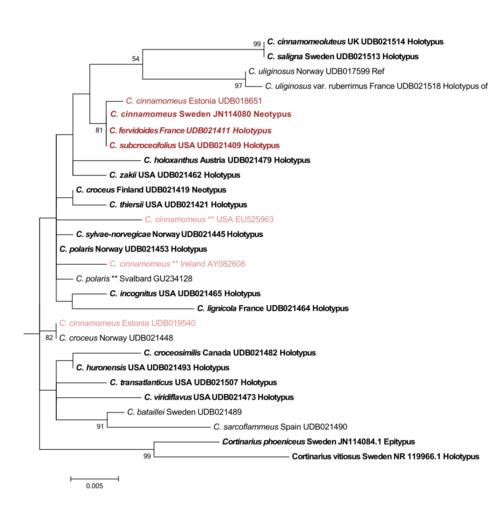MAKE A MEME
View Large Image

| View Original: | Maximum Likelihood-Tree-of-C.cinnamoneus.svg (695x673) | |||
| Download: | Original | Medium | Small | Thumb |
| Courtesy of: | commons.wikimedia.org | More Like This | ||
| Keywords: Maximum Likelihood-Tree-of-C.cinnamoneus.svg Molecular Phylogenetic analysis of Cortinarius cinnamoneus by the Maximum Likelihood method<br/> The evolutionary history was inferred by using the Maximum Likelihood method based on the Tamura 3-parameter model 1 The tree with the highest log likelihood -1442 8567 is shown The percentage of trees in which the associated taxa clustered together is shown next to the branches the bootstrap test was performed with 1000 replicates A user-specified Minimum Evolution-tree was used as an initial tree in the heuristic search A discrete Gamma distribution was used to model evolutionary rate differences among sites 5 categories +G parameter 0 1184 The tree is drawn to scale with branch lengths measured in the number of substitutions per site The analysis involved only 29 nucleotide sequences All positions with less than 95 site coverage were eliminated That is fewer than 5 alignment gaps missing data and ambiguous bases were allowed at any position There were a total of 591 positions in the final dataset Evolutionary analyses were conducted in MEGA6 2 Type-sequences are in bold print Incorrect identifications are marked with ' ' All C cinnamoneus-sequences are reddish brown correct ones are dark reddish brown the incorrect pale reddish brown 1 Tamura K 1992 Estimation of the number of nucleotide substitutions when there are strong transition-transversion and G + C-content biases Molecular Biology and Evolution 9 678-687 2 Tamura K Stecher G Peterson D Filipski A and Kumar S 2013 MEGA6 Molecular Evolutionary Genetics Analysis version 6 0 Molecular Biology and Evolution30 2725-2729 The following sequences are taken from the NCBI Nucleotide-Genbank http //www ncbi nlm nih gov/nuccore/ http //www ncbi nlm nih gov/nuccore/JX045670 C aurantiobasis JX045670 Holotypus http //www ncbi nlm nih gov/nuccore/FJ039589 C cf cinnamomeus FJ039589 http //www ncbi nlm nih gov/nuccore/FJ157025 C cinnamomeus FJ157025 http //www ncbi nlm nih gov/nuccore/FJ717560 C cinnamomeus FJ717560 http //www ncbi nlm nih gov/nuccore/FJ845396 C cinnamomeus FJ845396 http //www ncbi nlm nih gov/nuccore/HQ604650 C cinnamomeus HQ604650 http //www ncbi nlm nih gov/nuccore/AY082608 C cinnamomeus AY082608 http //www ncbi nlm nih gov/nuccore/AY750159 C cinnamomeus AY750159 http //www ncbi nlm nih gov/nuccore/EU525963 C cinnamomeus EU525963 http //www ncbi nlm nih gov/nuccore/JX436890 C cinnamomeusJX436890 http //www ncbi nlm nih gov/nuccore/JN114080 C cinnamomeusJN114080 http //www ncbi nlm nih gov/nuccore/GU234128 C polaris GU234128 http //www ncbi nlm nih gov/nuccore/DQ367899 C semisanguineus DQ367899 http //www ncbi nlm nih gov/nuccore/JN114084 Cortinarius phoeniceus JN114084 1 http //www ncbi nlm nih gov/nuccore/NR_119966 Cortinarius vitiosus NR 119966 1 All other sequences are from the https //plutof ut ee/ /datacite/10 15156/BIO/SH222334 07FU Unite/PlutoF Website own Created with MEGA6 and Inkscape 2016-03-06 Thkgk Cc-zero other versions Cortinarius cinnamomeus Cc-zero | ||||